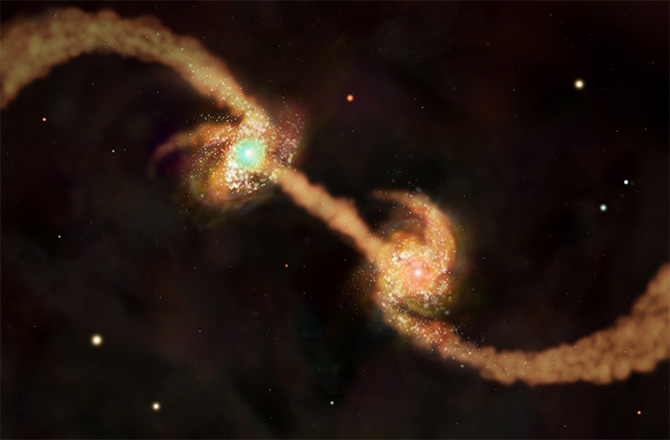Supermassive Diet: Black Holes Bulk-Up on Dark Matter

It has long been assumed that the size of a supermassive black hole in a galaxy's core is intimately related to the number of stars that galaxy contains — but it might not be that simple after all.
VIDEO: What if the Big Bang Never Happened?
Every galaxy is cocooned inside a massive halo of dark matter, the invisible stuff that is thought to account for nearly 85 percent of all matter in the universe. The bigger the galaxy, the bigger the dark matter halo. The stars that we observe in any given galaxy accounts for a tiny fraction of the total mass of that galaxy — the halo can extend for hundreds of thousands of light years from the visible galaxy's 'edge.'
The visible stars and gas in a galaxy can therefore be thought of as just the 'hub' of that galaxy; the rest of the 'wheel' extends far into intergalactic space, but as it is composed of dark matter, which does not interact with electromagnetic radiation (light), it cannot be seen. [Gallery: The Search for Dark Matter]
Although astronomers have known about these halos for some time, their gravitational impact on the visible stuff (stars, planets, gas) inside their host galaxies is poorly understood. And now dark matter's impact on black hole evolution is under scrutiny.
ANALYSIS: Did 'Dark Stars' Spawn Supermassive Black Holes?
"There seems to be a mysterious link between the amount of dark matter a galaxy holds and the size of its central black hole, even though the two operate on vastly different scales," said lead author Akos Bogdan of the Harvard-Smithsonian Center for Astrophysics (CfA), Cambridge, Mass. Bogdan's work, co-authored with Andy Goulding (of Princeton University), has been accepted for publication in The Astrophysical Journal.
Get the Space.com Newsletter
Breaking space news, the latest updates on rocket launches, skywatching events and more!
The majority of galaxies are thought to contain a supermassive black hole in their cores and, by studying over 3,000 elliptical galaxies, Bogdan and Goulding gauged the masses of their monster black holes by clocking the speeds of the stars whizzing around the central black holes.
Then, to measure the total mass of dark matter those galaxies possessed, the researchers observed the X-rays generated by the hot gas the galaxies contained. The more hot gas the galaxy has, the more massive its halo.
ANALYSIS: Black Holes as Exotic Particle Honeypots?
With this information in hand, the researchers were able to deduce that there is a strong relationship between the amount of halo dark matter and mass of the central black hole. This dark matter correlation is much stronger than the relationship between the number of stars and black hole mass.
As elliptical galaxies are products of galactic mergers — i.e. many galaxies clumping together over billions of years — the final elliptical is not only composed of many galaxies-worth of stars, but also a reservoir of all the dark matter those galaxies contained. Dark matter therefore has the dominant gravitational impact, dominating galactic evolution and guiding black hole growth.
"In effect, the act of merging creates a gravitational blueprint that the galaxy, the stars and the black hole will follow in order to build themselves," said Bogdan.
Source: CfA press release
This article was provided by Discovery News.
Join our Space Forums to keep talking space on the latest missions, night sky and more! And if you have a news tip, correction or comment, let us know at: community@space.com.
Ian O'Neill is a media relations specialist at NASA's Jet Propulsion Laboratory (JPL) in Southern California. Prior to joining JPL, he served as editor for the Astronomical Society of the Pacific‘s Mercury magazine and Mercury Online and contributed articles to a number of other publications, including Space.com, Space.com, Live Science, HISTORY.com, Scientific American. Ian holds a Ph.D in solar physics and a master's degree in planetary and space physics.









